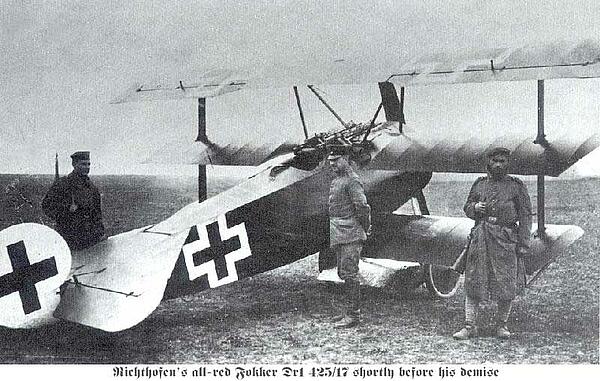Fokker Dr1 Triplane
The Fokker Dr.1 Tri-plane was Germany’s most famous fighter plane during World War One, acting as the German response to the British Sopwith Triplane following its success in the Battle of Arras in April 1917.
After a Sopwith crashed behind enemy lines, it was stripped down and studied by German aerial designers, subsequently being publicly praised by commander of the Imperial German Air Service (IGAS) - General von Höppner. Many attempted to copy the design for IGAS, but it was Fokker who was successful having not only studied the crashed Sopwith first hand but also having flown one himself.
In June 1917, Fokker’s chief designer, Reinhold Platz began remodelling a plan he had for a prototype known as D.V1, which had been designed for the Austro-Hungarian Air Force. It first flew on 1st July 1917 with famous German flying ace Werner Voss I the cockpit.
Unlike with the Sopwith Tri-Plane only the top wing of the D.V1 had ailerons. The lower and middle wings were also attached to the fuselage, while the top wing was much higher above it and was attached by steel-tube struts. The plane was given a powerful 110 hp engine and was armed with two 0.31 inch LMG 08/15 guns.

Platz began working on a new design of the D.V1 plane for the IGAS and adjusted it to give it ailerons that were squared at the wing tips. Voss spent more than 20 hours testing the plane in August 1917, including in combat, and Fokker also flew them to get a feel for the plane. The three men then got together to discuss what they felt needed improving, and the first true Fokker Dr.1 Tri-plane flew on 30th August 1917.
Voss managed to shoot down an Allied aircraft on his first flight in the Fokker Dr.1, and it was also the aircraft that flew Manfred von Richthofen to his 60th success. Voss managed to claim 20 confirmed killed in just 24 days flying the Fokker Dr.1 but was killed on 23rd September when six SE 5’s attacked him. However, the plane continued to see success, with other German aces claiming a number of victories including Erich Löwenhardt - who had 53 kills - and Ernst Udet - who had 62 kills.
The Dr.1 was considered to be a very strong but manoeuvrable aircraft, fitted with 110 hp engines that seemed to be very effective when combined with three wings. It also had a great rate of climb and the ability to turn quickly, which made it a lethal aircraft to face in a dog fight. However, the plane did have two major failings - its speed was not as good as some other Allied fighters and it also had a relatively short time in the air - managing just 80 minutes before it required refuelling. However, its advantages were strong and made it a formidable opponent in the air.
The Dr.1 was quickly introduced into combat and from October 1917 it played an important role on the Western Front, with 318 being built. It became particularly famous due to its role in boosting the success of a number of famous flying aces, including Voss and Richthofen. However, it did suffer from teething problems due to manufacturing issues. In the first two weeks of its service, a number of Dr.1s crashed with the fault being traced back to poor workmanship on the wings. This led to all of the planes being grounded until the problem was corrected. Almost all of November 1917 was spent correcting the wings and ensuring the struts were adequate for the plane.
This problem and the time taken to develop the plane meant that the Fokker Dr.1 spent only a relatively short time in active service. However, Richthofen’s ‘flying circus’ ensured that it remained in the public eye both during and after the war. Richthofen owned two of the planes and was the highest scoring ace of World War One, with 80 confirmed kills. Around 60 of these were achieved with other planes, but his name is still linked with the Fokker Dr.1 as he was killed on 21st April 1918 while flying one.
The number of Fokker Dr.1s in active service peaked in May 1918 at 171 aircraft. However, they were quickly succeeded by the Fokker D.VII and by June 1918 the remaining Dr.1s were withdrawn to Germany to protect the country from invasion.
The Treaty of Versailles forbade Germany to have an Air Force and so after the war the French took a number of Dr.1s back to France.
MLA Citation/Reference
"Fokker Dr1 Triplane". HistoryLearning.com. 2024. Web.
